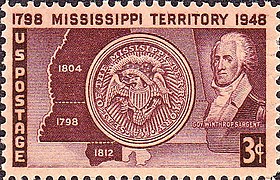This article's lead section may be too short to adequately summarize the key points. (September 2021) |
| Territory of Mississippi | |||||||||||||||||
|---|---|---|---|---|---|---|---|---|---|---|---|---|---|---|---|---|---|
| Organized incorporated territory of United States | |||||||||||||||||
 | |||||||||||||||||
| Capital | Natchez | ||||||||||||||||
| • Type | Organized incorporated territory | ||||||||||||||||
| History | |||||||||||||||||
• Mississippi Organic Act passed | 7 April 1798 | ||||||||||||||||
• Georgia recognizes its present borders | 1802 | ||||||||||||||||
• Georgia cession added to Mississippi Territory | 1804 | ||||||||||||||||
• Mobile District annexed | 1812 | ||||||||||||||||
• Alabama Territory created | August 15, 1817 | ||||||||||||||||
| 10 December 1817 | |||||||||||||||||
| |||||||||||||||||

The Territory of Mississippi was an organized incorporated territory of the United States that was created under an organic act signed into law by President John Adams on April 7, 1798.[1] It was dissolved on December 10, 1817, when the western half of the territory was admitted to the Union as the State of Mississippi. The eastern half was redesignated as the Alabama Territory; it was admitted to the Union as the State of Alabama on December 14, 1819. The Chattahoochee River played a significant role in the definition of the territory's borders. The population increased in the early 1800s from settlement, with cotton being an important cash crop.

